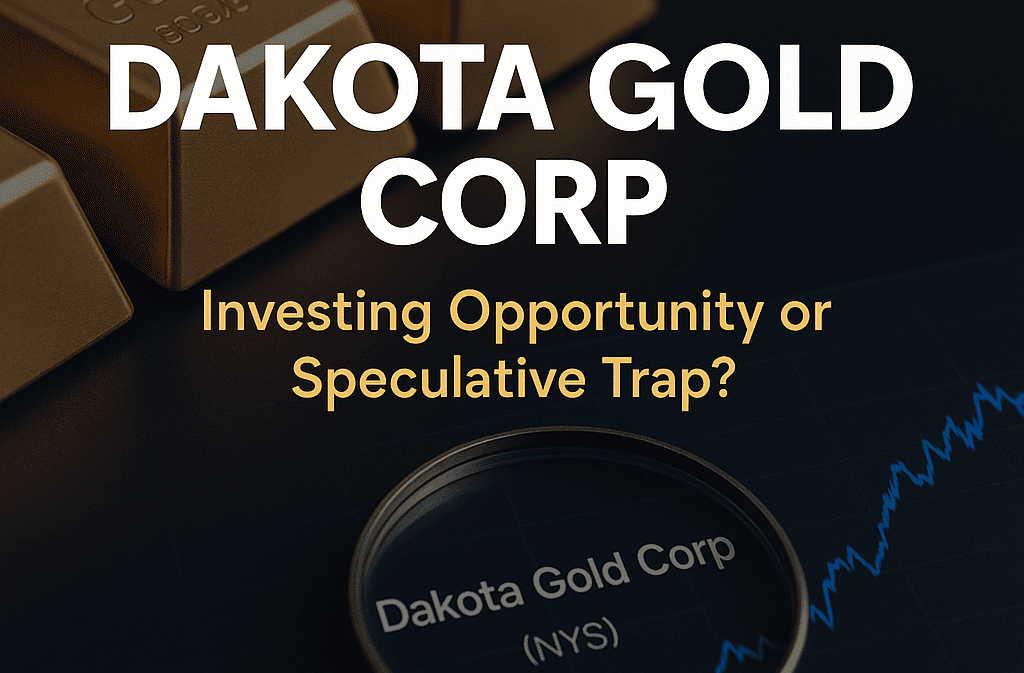Gold in the Ground, or a Mirage in the Market?
A full-spectrum financial and macroeconomic analysis of a speculative gold explorer
Introduction: Gold Glitters Again—But Should You Bet on It?
In an increasingly volatile global economy, investors are once again turning to gold—not out of nostalgia, but necessity. With inflation hanging stubbornly above target, interest rates stalling at multi-decade highs, and geopolitical fractures reshaping global trade and currencies, gold has regained its historical role as a monetary anchor and portfolio hedge.
Into this climate steps Dakota Gold Corp—a pre-revenue mining exploration company with a tantalizing narrative: reviving gold operations in the legendary Homestake District of South Dakota. It’s a story that offers echoes of American mining glory and promises to unearth value where giants once thrived. But is it compelling enough for capital—or is it just another high-cost dig in an increasingly crowded junior gold market?
Digging into the Business Model
Dakota Gold isn’t mining gold yet—it’s looking for it. And that distinction makes all the difference. The company’s model is based entirely on acquiring and developing mineral-rich land in hopes of proving an economically viable resource. If successful, they may then either sell to a larger miner, enter into a joint venture, or move toward production themselves.
They currently produce no revenue, and their income statement is a sea of red ink. Their trailing twelve-month operating loss sits at $29.35 million, with free cash flow even deeper in the red at $25 million. To fund this activity, Dakota relies on issuing shares—a practice that has ballooned the share count from 86 million to nearly 112 million within just two years.
A key financial concern here is stock-based compensation. In 2024 alone, Dakota paid out nearly $3 million in equity-based pay to management and employees. In a company with no income, every share given to insiders is a share diluted from existing investors. This isn’t inherently unethical—early-stage ventures often use equity for talent retention—but it becomes questionable when not tied directly to performance or measurable milestones.
Yet for all the red flags, there’s a surprisingly strong balance sheet. The company holds $9.4 million in cash and has minimal debt. Its current ratio is above 3.6, suggesting it’s more than capable of meeting its near-term obligations. But make no mistake: without new capital or a breakthrough in exploration, this liquidity could dry up within a year.
Financial Health Snapshot
- Cash on hand: $9.4M
- Debt: Minimal
- Current Ratio: 3.62
- Operating Loss (TTM): $29.35M
- Stock-Based Compensation: $2.93M
- Free Cash Flow: -$25M
- Revenue: $0
The Macro Backdrop: Gold, the Fed, and the Geopolitical Clock
Junior miners like Dakota do not trade on cash flows—they trade on expectations. And those expectations are largely set by the macroeconomic and geopolitical backdrop. For Dakota Gold, three key macro variables could be either wind at its back or an anchor to its ankle.
1. The Federal Reserve and Interest Rates
Gold and real interest rates are natural enemies. When real rates are high, gold becomes less attractive—after all, gold pays no yield. In 2024 and into early 2025, the Fed maintained a hawkish stance, holding rates above 5% and sending real yields (nominal minus inflation) to their highest levels in nearly 15 years. This capped gold’s rally, despite inflation and geopolitical stress.
However, cracks are forming. The Fed has paused rate hikes, citing slowing growth, and markets are beginning to price in two potential cuts before mid-2026. Should real yields decline—even modestly—gold could surge.
2. Inflation and Dollar Devaluation
While headline inflation has cooled, core services and wage inflation remain elevated. Combined with long-term fiscal imbalances, the dollar’s purchasing power continues to erode—albeit subtly. A weakening dollar directly supports gold, and for junior miners like Dakota, rising gold prices provide both narrative tailwinds and access to more favorable capital.
3. Central Bank Gold Demand and Geopolitics
Central banks—particularly in the BRICS+ bloc—have been loading up on gold, viewing it as an alternative to U.S. Treasuries and a hedge against de-dollarization. If this demand continues to rise in 2025, it supports long-term price floors for gold.
Dakota Gold’s Future: Moonshot or Mirage?
If Dakota Gold proves its deposits viable, it could be a multi-bagger. Its historic land positions near the Homestake Mine give it strong geological credibility. Add in a macro backdrop where gold breaks out above $2,200/oz and you suddenly have a very hot asset with takeover potential. Larger miners frequently acquire juniors with proven reserves, especially in politically stable jurisdictions like the U.S.
But this remains a binary outcome. Without strong drill results or a credible resource estimate, the company will likely continue to fund operations via share issuance—diluting shareholders further. The market, meanwhile, grows impatient with juniors that fail to show progress beyond press releases and maps.
Strategic Positioning Takeaways
- Best case: High-grade drill results + gold rally = major re-rating
- Base case: More dilution, moderate narrative-driven pops
- Worst case: Capital runs out, no commercial viability, stock collapses
- Prudent approach: Treat it like a long-dated call option—not a core holding
Verdict: A Glimmer of Gold, But Uncut and Unconfirmed
Dakota Gold Corp offers what many speculative investors crave: asymmetric upside. In a world where hard assets are regaining favor, and gold is flirting with multi-year highs, a discovery-stage miner in a historic district has undeniable allure. But allure is not earnings. Not yet.
For the moment, Dakota remains a promise, not a product. The fundamentals cannot justify investment alone—only the convergence of macro tailwinds and operational catalysts can. Until then, it belongs on a watchlist for gold bulls and speculative traders with an appetite for high-risk, high-reward plays.
You don’t buy Dakota Gold to hedge your portfolio. You buy it if you believe something big might happen—and you’re okay if it doesn’t.
Disclaimer:This article is an analysis and opinion piece and should not be taken as financial advice. Always conduct your own research or consult a financial professional before investing.

